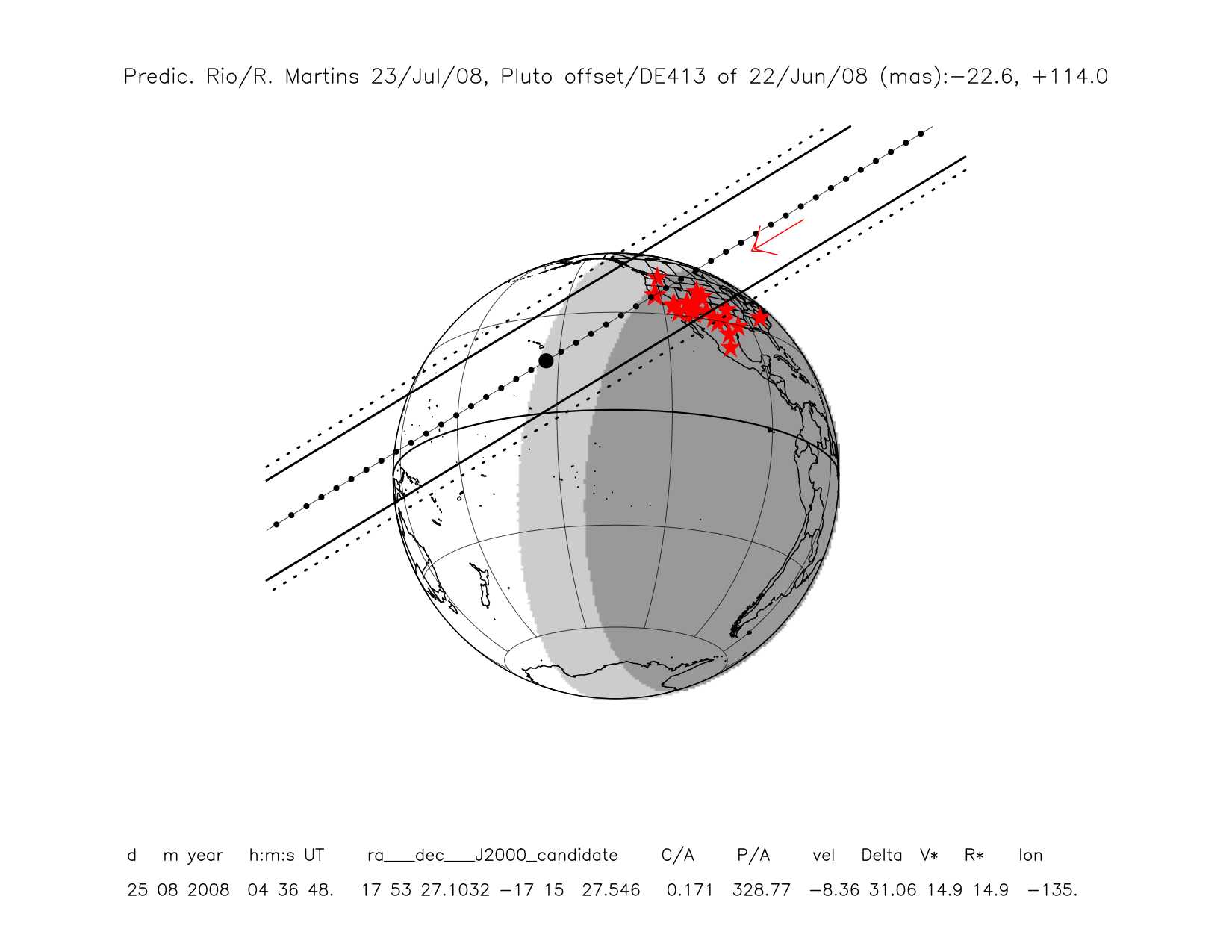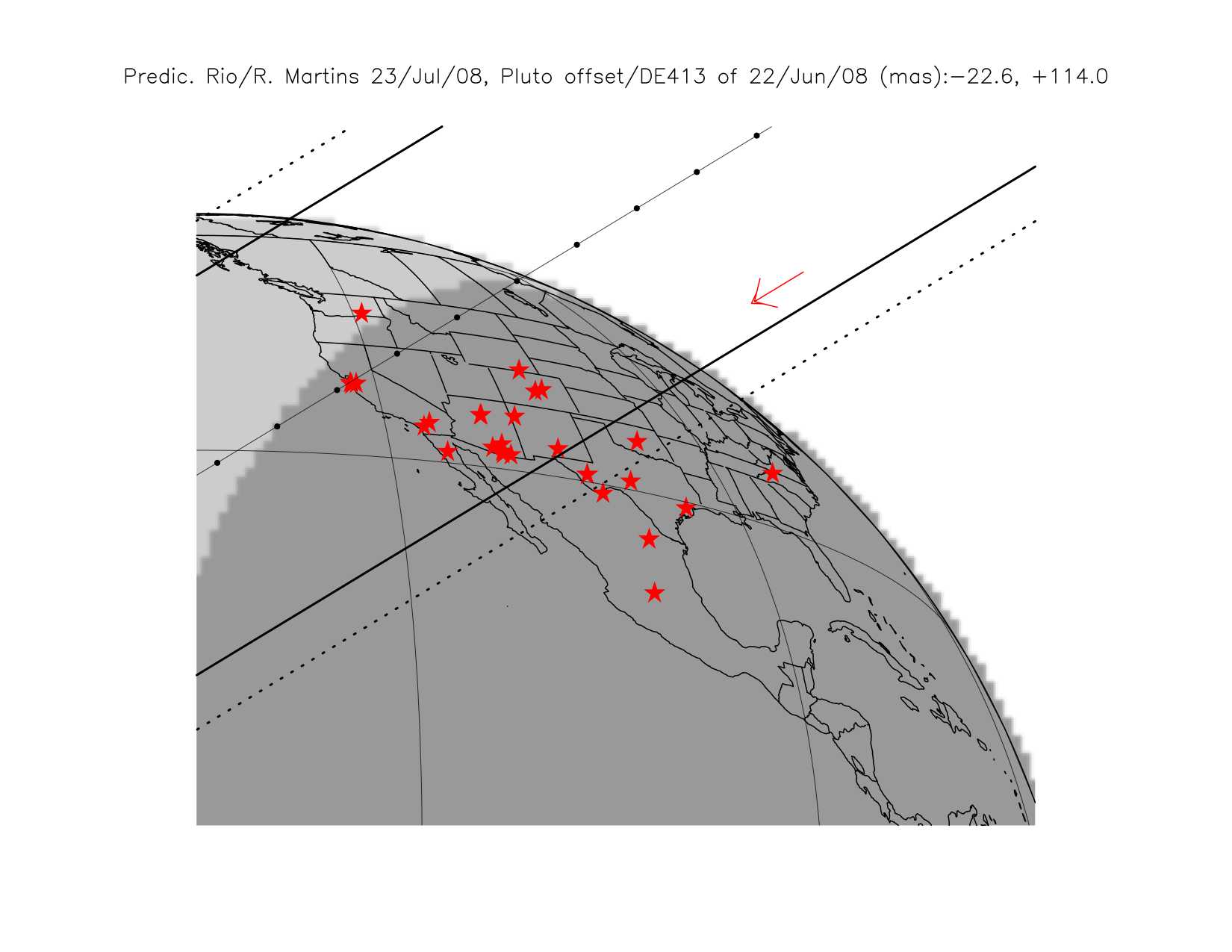click |
click |
The Pluto stellar occultation of 24/25 August 2008
Last update: 22 August 2008
Do not forget to read the observing tips below for better scientific returns!!!!On 25 August 2008 near ~ 04:25 - 04:30 UT (i.e. the EVENING of 24 August 2008 in N. America), Pluto will occult a star. The event could be observed from Mexico and USA.
Recent (9 July 2008) observations made at Pico dos Dias with a 1.6m-telescope in I band provides the following star position
(Roberto Vieira Martins, Marcelo Assafin et al.,
Observatório Nacional, Rio de Janeiro and Univ. Federal Rio de Janeiro):
α = 17h 53mn 27.1032 sec
δ = -17d 15' 27.546" (ICRF J2000 using the UCAC2 star catalog)
with typical absolute uncertainties of 30 mas, corresponding to about 700 km in the Bessel plane.
A recent stellar occultation by Pluto and Charon observed on 22 June 2008 from Australia and La Réunion Island provides
the following offset for Pluto position with repect to the DE413 ephemeris:
Δ α= -23 mas
Δ δ= +114 mas
click |
click |
The shadow moves from upper right to lower left left. Dots on centerlines are plotted every mn. The larger dot is for geocentric closest approache, namely 04:36:48 UT (NB. August 25, i.e. **evening** of August 24 in N. America). Solid lines is where the star reaches its half-light level, due to differential refraction by Pluto's atmosphere. Dotted lines are where the stellar drop is only 1% drop, and mark the limits where the occultation can practically be detected. Red star symbols are potential observing sites. NB. error in timing can be up to 3-5 mn. Error in shadow path can be up to 700 km.
- the center of the event should be around 04:25 - 04:30 UT in Mexico and USA. Errors of up to 3-5 mn in
announced timings are possible, so PLAN YOUR OBSERVATIONS ACCORDINGLY !!!
- the event is slow (about 8.4 km/sec), so the occultation can last for up to 6 mn, if central. Even data taken at cycle
times of 1 to 5 sec or more can be useful.
Try to minimize the dead time between frames, compared to the exposure time of each frame.
For instance, there is not much advantage having an exposure time of 0.5 sec if the read/write time of the image is
6 sec, as most of the photons will be lost. It is better than to have an exposure time of 6 sec, to get at least 50% of
the photons.
- be very careful in getting a GOOD ABSOLUTE TIMING of each of your image. This is of great importance when reconstructing
the geometry of the event using various stations.
- if the occultation is central, an increase of light (the so-called "CENTRAL FLASH") may be visible at mid-occultation for several seconds.
Such flash is most useful to constrain the amount of dust possibly present in the deepest Pluto atmospheric layers.
If observed from various sites, it is also very useful to measure the speed of winds in Pluto's lower atmosphere.
- the star is VERY RED. The contrast of occultation will be POOR in visible. Even in R, the star is 1.4 mag. fainter (i.e. 3.6 times fainter)
than Pluto see table below. I band is more favourable, as the maximum drop of the combined star+Pluto flux can reach 35-40% during the event.
TESTS SHOULD BE PERFORMED BEFOREHAND to optimize SNR according to your
instrument and receptor.
Remember that filters can help increase the contrast, but they reduce the photon flux.
So, compromises should be attained, that WILL DEPEND ON TELESCOPE SIZE.
- IT IS EXTREMELY IMPORTANT, for further analysis, to be able to take away Pluto's flux from the
light curve, which will consist in the SUM of the star and Pluto fluxes.
For instance, if the occultation is grazing, then the star will not disappear entirely behind Pluto.
Thus, the real depth of occultation can be determined only if Pluto's contribution is properly subtracted
to the flux. The real depth of occultation is then important to constrain both Pluto's atmospheric pressure
and the reconstruction of the occultation geometry.
This means carefully calibrating Pluto's flux vs. the stellar flux before or after the event,
when they are well separated. The problem is that the star being VERY RED, and Pluto more neutral,
the ratio star/Pluto WILL CHANGE WITH AIRMASS. So, such calibration may result useless.
Also, measuring Pluton on a different night for comparison is not advised, as the
planet brightness varies by up to +/- 15% during its 6.4 rotational period.
- A solution is then to take another star in the FoV (or **better**, several other stars) as reference(s),
and measure their relative fluxes, together with the occulted star, on other night(s) AT THE SAME AIRMASS as for the occultation,
with the SAME FILTER, DETECTOR, TELESCOPE, etc..., thus allowing us to retrieve Pluto's contribution to the
occultation light curve.
Note also that using MORE THAN ONE reference star has the advantage to be able to measure those reference stars
with respect to each other, thus giving the opportunity to check the overall consistency of the calibration. For instance, if
the ratio of two (or more) reference stars is not the same during the occultation and during the calibraton night(s), then it means
that conditions varied and chromatic effects are not the same anymore, or that the stars are variables, etc...
Be careful also that some detectors (e.g. video, or Watec cameras when the "gamma" is no set to unity) are NOT LINEAR, so that
calibration is meaningless in those case, unless non-linearity is accounted for. Again, do not forget to set "GAMMA=1" (or "NO GAMMA")
on some cameras.
- Note that the calibration NEEDS NOT BE DONE WITH THE SAME INTEGRATION TIME as for the occultation. Taking longer integration time will improve
the SNR of the calibration and reduce the amount of data. This assumes, however, that the receptor is linear, i.e. that a longer integration
time will respect the various flux ratios measured in the FOV.
- Finally, do not forget to take DARKS and FLATS.
| Star magnitudes: | R= 15.2 | I= 14.0 | J=12.0 | H= 11.1 | K= 10.7 |
| Pluto: | R= 13.8 | I= 13.5 | J= 13.0 | H=12.9 | K= 13.3 |
NB. Independent predictions and information (charts, etc...) are given in the following pages:
the SWRI (Leslie Young) page
(where the various predictiosn are discussed) and
the MIT page
NB. Results obtained during the 18 March 2007 Pluto occultation in USA are available here (bottom of the page). This may give an idea of what can be obtained during a Pluto occutation.
For contacts, more information and/or comments, you can contact me email at:
bruno.sicardy@obspm.fr